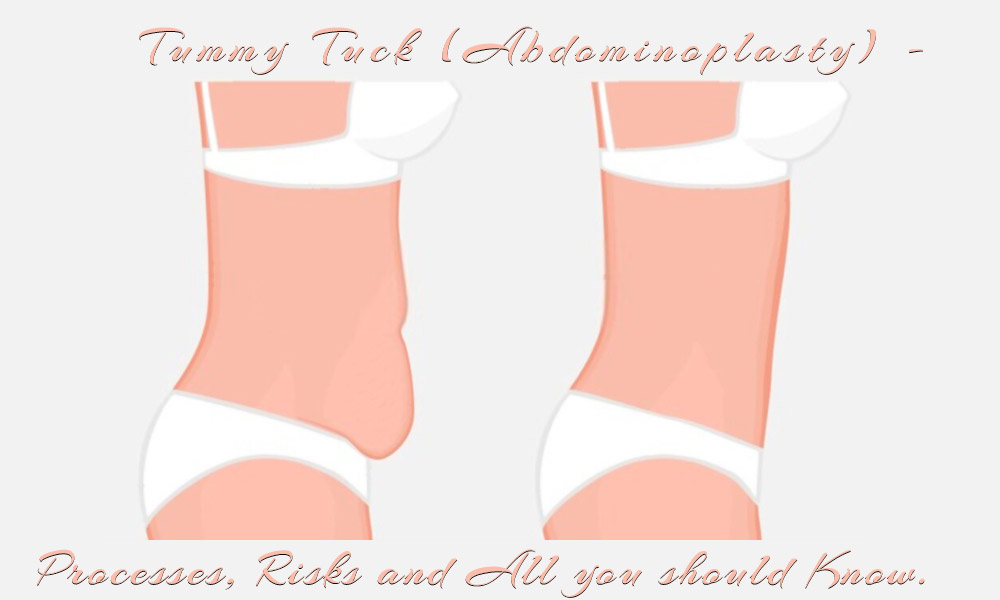No products in the cart.

Tummy Tuck (Abdominoplasty) – Processes, Risks and All you should Know.
Are you here because sit-ups, HIIT exercises and diet combinations are not giving you the taut or firm tummy look and feel you want? Everyone knows how ridiculously difficult dealing with belly fat can be, especially if accumulated over time. If the problem is too much flab or excess skin in your belly area that doesn’t respond to anything, you might want to consider a “tummy tuck,” which the experts call “abdominoplasty.”
A tummy tuck, also called “Abdominoplasty”, is a surgical process designed to improve the overall look of your midsection or belly area hence the name prefix ‘abdomino’. Experts of the procedure claim it makes your stomach look flatter, firmer, and smaller. The process is performed majorly by plastic surgeons and is viewed as a “cosmetic” fix.
As a tool, a tummy tuck can be used to boost your body image. During the process of a tummy tuck, excess skin and fat are removed from the abdomen, while a fascia or connective tissue in the stomach is tightened using sutures. The skin that is left is then transposed to create a firmer look.
Tummy tuck isn’t for everyone. It might become an option if you have excess fat or skin around your belly button or abdominal area or a weak lower abdominal wall/core. Still, you must confirm from a trained professional if it is an option for you.
Different factors determine if you are a candidate for the tummy tuck procedure, beyond all you read on the internet.
How to determine if you are a Good Candidate for Abdominoplasty?
First, let’s look at a few reasons you might want to consider going under the knife for this process. A tummy tuck can be done on both men and women who must be in good health. This is a major surgery, and lives have been lost due to complications arising from undisclosed health issues during the surgery.
For women who have had several pregnancies, the procedure helps firm up their abdominal muscles and reduce flabby skin. An abdominoplasty is also helpful for men or women who were obese at one time and want to get rid of excess fat deposits or loose skin hanging around the belly.
There are several other reasons you might have; some includes;
- Excess abdominal fat.
- Poor elasticity of the skin.
- Weakened connective tissue in your abdomen.
- Significant weight changes or excess weight loss.
- Post-Pregnancy issues.
- Other abdominal surgery, such as a C-section or liposuction.
Ageing issues. - Specific natural body type.
- Excess abdominal fat.
A tummy tuck can improve loose or excess skin plus fat folds in the belly area and firm up weak fascia if carried out by a professional. Abdominoplasty can also be used to remove very unsightly stretch marks in the lower abdomen just below the belly button. That said, a tummy tuck can’t be used to correct stretch marks outside of this area.
In addition, if you’ve previously undergone a C-section, a certified, skilled or experienced plastic surgeon might be able to hide any existing C-section scar into your tummy tuck scar. As stated earlier – tummy tuck isn’t for ‘every Tom, Dick and harry’. Your surgeon might refuse or might caution against undergoing an abdominoplasty if you:
- Want to lose a lot of weight, maybe due to health reasons.
- Might want to get pregnant in future.
- Are a smoker.
- Are a patient of a severe or chronic health condition, such as heart disease or diabetes.
- Have a body mass index higher than 30.
- Have a previous unsightly scar tissue from previous abdominal surgery.
- Want to lose a lot of weight, maybe due to health reasons.
Your surgeon will and should refuse to give you the surgery due to the reasons stated above. In the case of pregnancy or significant weight loss, having the surgery can stretch out the skin around your stomach. A tummy tuck can be very useful in restoring the look of a flat and contoured midsection.
An abdominoplasty might also involve bringing the rectus abdominus, or sit-up muscles, back together mostly if they’ve been stretched or separated by pregnancy. This will be determined by your surgeon as well.
A tummy tuck can also be done with other contouring cosmetic body procedures, such as breast surgery or liposuction. If you’ve had belly fat removed from your abdomen (via liposuction), you may qualify for a tummy tuck because liposuction expels fatty tissue right under the skin, not the skin.
What is the procedure like?
A tummy tuck can be completed in one procedure and can go on from one to five hours. An overnight stay in the hospital might be necessary, depending on your case. General anaesthesia will be administered to put you to sleep. After the sedation, an incision will be made at the bottom of the skin that covers the abdominal wall.
Once the muscles are visible, your surgeon will join the muscles in your abdominal wall together by sowing them if they are stretched out or loose. Next, the skin will be pulled over your abdomen, excess skin will be trimmed off, and the incision closed with sutures.
How should I prepare for an abdominoplasty (tummy tuck)?
The first thing is to talk to your surgeon or physician about your suitability in undergoing the process. At the first visit, your surgeon will make inquiries regarding your medical history – you will be required to share vital, even private, information about your medical status, past, and current.
This is in your best interest. Talk about every minute detail, no matter how embarrassing. Give information regarding current medications, if you are on any, as well are past surgeries. Tell the surgeon about any allergies – both food allergies and drug allergies. If weight loss is at the core of your desire for a tummy tuck, then your doctor might ask more detailed questions.
- Physical exam necessity: Your doctor will have to carry out a thorough physical examination to determine your surgery or treatment options.
- Discuss your hopes and expectations from the surgery: Be clear in explaining why you want a tummy tuck and your expectations regarding your appearance after the procedure. Ensure you clearly understand all the benefits and risks, including the scars. Note that any previous abdominal surgery might reduce your results.
Some other precautions to take includes;
- Maintain a healthy balance. Eat well-balanced meals but don’t diet excessively before the surgery. Proper nutrition supplies your body with the nutrient needed for true healing.
- Your surgeon may instruct that you stop taking certain kinds of medications that have harmful effects or properties in terms of the surgery, like blood thinners and/or dietary supplements, for some time before and after the surgery as part of your pre-operative consultation. Some of these drugs may include aspirin and nonsteroidal anti-inflammatories (NSAIDs).
- No smoking. This can delay healing and increase the risk of complications. It would be best if you completely stopped this habit and cut all forms of nicotine intake – for at least one month before and two weeks’ post-surgery. The rule is, the longer you stop, the better.
- Ensure you set up a comfy, safe recovery space where you can rest and recover post-surgery before you go for surgery.
- Maintain a healthy balance. Eat well-balanced meals but don’t diet excessively before the surgery. Proper nutrition supplies your body with the nutrient needed for true healing.
Your Expected Results?
Yes, abdominoplasty claims long term results, but a careless lifestyle can cause significant weight gain and firmness loss after the procedure. The process is not the elixir of a perfect body.
According to Dr Alperovich of Yale Medicine, “Diet and exercise are the cornerstones of feeling and looking good”. You must do your part to maintain all you gained from the surgery.
Usually, after a tummy tuck, the results are seen as permanent. The abdominal wall will be more stable and firm. The excess skin expelled will only return due to weight fluctuations, bad diet, alcohol intake, or pregnancy. These factors might stretch out the area again.
What are the Possible Complications or Risks?
Abdominoplasty has been shown to have more complications/risks than some other cosmetic procedures. A recent study showed that 8.5 per cent of Trusted sources of people who underwent a tummy tuck procedure had to return to the hospital because of some complication.
Wound complications and infections were among the most common reasons for readmission. A tummy tuck can come with various risks and complications, including:
- Seroma: This is fluid accumulation beneath the skin. With the help of drainage tubes left in place after surgery, the risk of seroma happening can be reduced. The surgeon might also use a needle and syringe to remove excess fluid.
- Poor or slow wound healing. This can happen at any point during the initial healing phase. This is why movement and any form of strain are highly restricted right after the surgery. Also, you might be given antibiotics during and after the surgery to mitigate the onset of infection should the wound heal poorly or the incision line begins to separate.
- Seroma: This is fluid accumulation beneath the skin. With the help of drainage tubes left in place after surgery, the risk of seroma happening can be reduced. The surgeon might also use a needle and syringe to remove excess fluid.
Other risks include:
- Unexpected scarring
- Tissue damage or death/ Necrosis.
- Changes in skin sensation.
- Risk of bleeding,
- Infection.
- Adverse reaction to anaesthesia, etc.
- Unexpected scarring
Don’t be alarmed, as these risks are not particular to abdominoplasty but can happen with any surgery.
And the Recovery Process?
- Right after an abdominoplasty, your abdominal incision and belly button will likely be covered with surgical dressing. You will be provided with a compression garment or “belly binder” by your surgeon. Excess fluid or blood is drained from the incision site using miniature tubes.
- The medical support team will be on hand on the first day to assist you with your first movements – this movement is necessary to prevent the formation of blood clots.
- Due to the apparent discomfort, slight swelling and pain you will experience from the cuts and sutures, you likely will be placed on prescription pain meds and antibiotics to ease the discomfort and stop any infection.
- The fluid drains might need to stay in place for more days’ post-surgery. This is normal. You will be placed on antibiotics If this happens to stop any opportunistic infections. Also, your medical team or surgeon will show you how to empty the drains and keep them clean.
- Your surgeon might also prescribe blood thinners for a short period after the tummy tuck.
- You will wear a support garment/ abdominal binder for about six weeks after your tummy tuck to aid healing and provide support. These garments help prevent fluid build-up and provide abdominal support while you heal. Your medical team will explain how to clean and care for your scar.
- Right after an abdominoplasty, your abdominal incision and belly button will likely be covered with surgical dressing. You will be provided with a compression garment or “belly binder” by your surgeon. Excess fluid or blood is drained from the incision site using miniature tubes.
Before you leave the hospital or clinic, a series of regular follow-up visits will be scheduled for you based on the outcome of the surgery.
Results – A firm, flatter midsection with a dash of a confidence boost and elegant girth! The process of abdominoplasty removes excess skin, fat and strengthens your abdominal wall. It gives you a more toned and slimmer appearance.
The bottom line
Although tummy tuck both aims to improve or alter the appearance of your belly area, it must be done with a lot of caution and by qualified experts to avoid complications and/or fatal mistakes. Before you engage in this surgery, ensure you have all the basics covered with your surgeon and have prepared all you need for a smooth recovery period.
Remember that the real work begins after the surgery. You must maintain a healthy lifestyle and do all to retain the results. Still, your doctor or potential surgeon will be your best resource in determining how or if the procedure may be proper for you.







Hairstyles VIP
Good blog! I truly love how it is simple on my eyes and the data are well written. I’m wondering how I might be notified when a new post has been made. I have subscribed to your RSS which must do the trick! Have a great day!